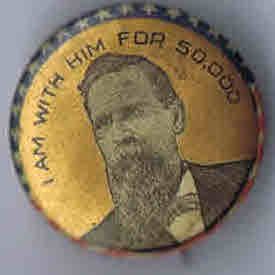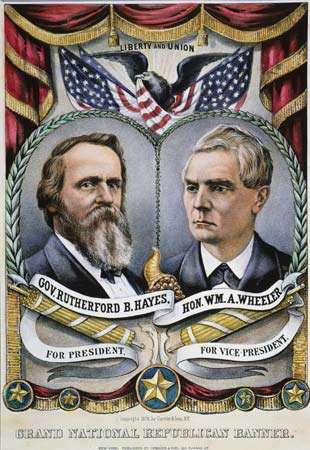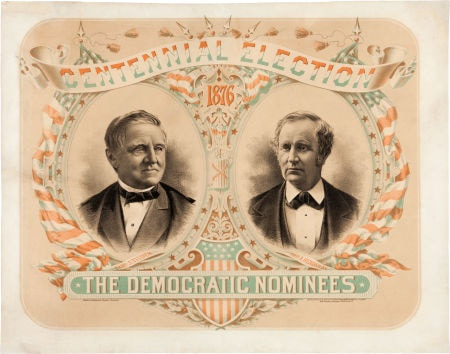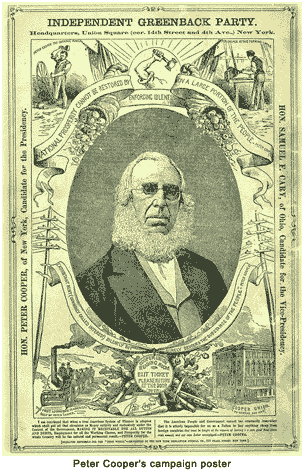Conventions, Candidates, and Campaigns
In the 1874 mid-term elections the Democrats for the first time since the Civil War held the majority in the House of Representatives. The Senate and most of the Federal government were still controlled by Republicans whose opinions were divided internally on the causes and solutions to address the current state of the Union.
The one thing Republicans were united on was that the Grant Administration had to go. Grant had thoughts of a third term, but the scandals implicating his administration and some of his closest friends had exhausted even his own party and the public’s patience. At that time Presidents did not have term limits but based on the precedent set by George Washington, it was assumed that they would only serve two terms. Term limits were not established until 1951, with the ratification of the Twenty-second Amendment. When word got out that Grant was considering another run, Republicans made it clear that they supported the two-term tradition for Presidents.
The two major parties held their conventions in June leaving only four months of active campaigning, not the two plus years of campaigning we have today.
The one thing Republicans were united on was that the Grant Administration had to go. Grant had thoughts of a third term, but the scandals implicating his administration and some of his closest friends had exhausted even his own party and the public’s patience. At that time Presidents did not have term limits but based on the precedent set by George Washington, it was assumed that they would only serve two terms. Term limits were not established until 1951, with the ratification of the Twenty-second Amendment. When word got out that Grant was considering another run, Republicans made it clear that they supported the two-term tradition for Presidents.
The two major parties held their conventions in June leaving only four months of active campaigning, not the two plus years of campaigning we have today.
Republicans Democrats
|
The Republicans nominated Rutherford B. Hayes, a former Union General, current Governor of Ohio, and considered a reformer. Second on the ticket was William A. Wheeler a Congressman from New York who was known for his integrity and competence. A testament to his virtue, he advised Hayes, that “capacity and character” should be a prerequisite for government appointment. The Platform endorsed Equal Rights covered under the Constitution, the Separation of church and public schools, protective tariffs, conservations of public lands, and pensions for Union Veterans.
|
The Democrats nominated the Governor of New York, Samuel Tilden, a lawyer and recognized reformer who was instrumental in the prosecution of the notorious Boss Tweed Ring. Thomas Hendricks, the former U.S. Senator and Governor of Indiana, was selected to run as Vice President. The Platform demanded a repeal of the 1875 Specie-Resumption Act, condemned the corruption of the Grant Administration; supported the Civil Rights (13th, 14th, and 15th) Amendments, denounced Reconstruction corruption, supported revenue only tariff, conservation of public lands, and civil service reform. |
The Greenback and Prohibition
Two recently formed third parties held their presidential nominating conventions in May 1876.
|
The Greenback Party nominated Peter Cooper, an inventor, industrialist, philanthropist and founder of Cooper Union. At age 85, he was the oldest candidate to ever run for president. The Party Platform focused on repealing the 1875 Specie Resumption Act of and other monetary issues. Cooper received over 80,000 votes. One vote he did not get was Abram Hewitt’s, his son-in-law and business partner. Hewitt was Chairman of the Democratic National Committee supporting Tilden in the election.
|

The National Prohibition Reform party nominated General Green Clay Smith, a former Congressman and Governor of the Montana Territory.
At the 1864 Republican Convention, Smith nearly became Abraham Lincoln’s running mate, losing to Tennessee’s Andrew Johnson by a single vote. The platform called for a constitutional amendment forbidding the “importation, exportation, manufacturing, and sales of alcoholic beverages”. It also supported Women’s Suffrage, the dissolution of the Electoral College, direct election of U.S. Senators, and an end to gambling. |
The Campaign
Hayes and Tilden’s positions on the major issues were identical: resumption of a gold-based currency, withdrawal of Federal troops from the South and civil-service reform. Interestingly, Tilden’s running mate was a soft money supporter. Both were sitting Governors of key states and did not actively campaign. Both accepted their nomination by letter detailing their views on the issues noted in the platform. Hayes pledged, if elected, not to seek a second term since he would be more effective in addressing the “spoils system”.
Democrats organized an innovative campaign strategy emphasizing the need for a clean, fiscally conservative government. They disseminated advertising and scheduled speakers across the country to address the different locality concerns. They also criticized their Reconstruction policies focused on the scandals of the Grant Administration and the need for reform after sixteen years of Republican control. The Republican approach was to squeeze money out of Federal Employees and presented the same theme of past elections of “waving the bloody shirt” and saving the Union.
The real bloody shirts belonged to Blacks in the South who were again; the victims of terror and intimidation. Louisiana and South Carolina saw tremendous violence with innumerable beatings and murders meant to discourage Blacks from voting.
During the election process Grant, who was not on the ticket, was indifferent to the outcome and unwilling to exercise federal powers to protect blacks as a result the Red Shirts, a white Democratic paramilitary group, canvassed the South preventing black and white Republicans from voting.
Democrats organized an innovative campaign strategy emphasizing the need for a clean, fiscally conservative government. They disseminated advertising and scheduled speakers across the country to address the different locality concerns. They also criticized their Reconstruction policies focused on the scandals of the Grant Administration and the need for reform after sixteen years of Republican control. The Republican approach was to squeeze money out of Federal Employees and presented the same theme of past elections of “waving the bloody shirt” and saving the Union.
The real bloody shirts belonged to Blacks in the South who were again; the victims of terror and intimidation. Louisiana and South Carolina saw tremendous violence with innumerable beatings and murders meant to discourage Blacks from voting.
During the election process Grant, who was not on the ticket, was indifferent to the outcome and unwilling to exercise federal powers to protect blacks as a result the Red Shirts, a white Democratic paramilitary group, canvassed the South preventing black and white Republicans from voting.


